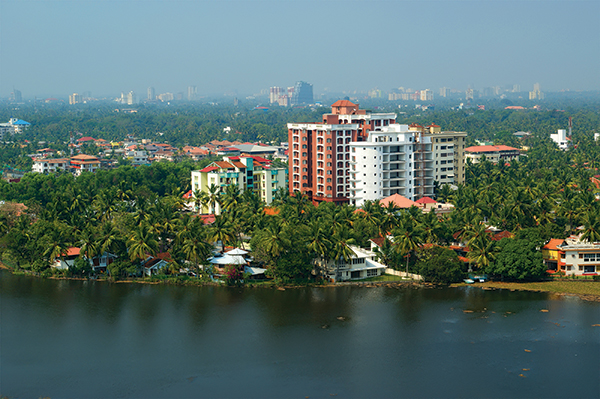In India, COVID-19 was nothing short of a humanitarian crisis disrupting lives, business and the ways in which people worked. As the pandemic set in, much like other parts of the world, tens of millions of employees adjusted to working from home (WFH). Daily tasks such as meetings, customer interactions and conferences were conducted from bedrooms, living rooms or dining room tables as traditional offices were closed for months. Initially, India’s public and private sectors offered WFH options for only a small fraction of their workforces, but this changed rapidly. While companies focused on ensuring business continuity and launching initiatives to enable remote work, the government played a critical role by being more flexible in implementing regulations to facilitate WFH.
The Department of Telecommunications (DOT) modified its licensing requirements for a category of companies called Other Service Providers (OSPs), enabling India’s 4.5 million workers in software development, business process outsourcing and call centers to WFH almost overnight.
Before these rules were made simpler, OSPs had to provide detailed information on the number of telecoms lines being used, types of services provided, whether they were international or domestic as well as the locations in which static IPs were used. Companies also had to register with the DOT and Ministry of Corporate Affairs. This was an unsustainable compliance burden for companies needing to facilitate WFH. New guidelines were developed that significantly reduced this burden, lowered the cost of compliance and facilitated resource utilization in a WFH environment.
Benefiting From an Accelerated Digital Revolution
Technology has played a dominant role in the COVID-19 world, transforming everything from doctor appointments to education to exercising online. Digital transformation to accommodate remote working accelerated significantly while cloud and digital solutions were adopted by businesses across the globe, a feat that would have taken years to accomplish otherwise. The pandemic drove increased demand for collaboration tools, telehealth, cybersecurity, digital transformation services and artificial intelligence.
Garima Goenka, with IDC India, noted that since 2020, “the focus of IT service vendors has shifted to addressing the challenges of remote connectivity and collaboration, connecting with their ecosystem of customers, suppliers and partners, while also ensuring business continuity, building organizational resilience and being more adaptable.”
Global information technology spending in 2021 is forecast to reach US$4.1 trillion, an increase of 8.4% over 2020, according to Gartner, Inc. The Indian technology industry body NASSCOM predicts about $200 billion of this expenditure will be captured by Indian IT companies. Certainly COVID-19 has changed the way we live and work, and information technology has facilitated this transition. This “new” way of life will be a significant driver for the continued growth and development of India’s information technology and information technology-enabled services (IT/ITES) sectors as the impact of where talent is located becomes less important.

These Tier-2 cities in India are among key locations highlighted by analysts and by company project locations in recent months.
There’s No Place Like Home
Remote work has changed India’s working culture in many of the same ways it has in the West. Indian professionals are moving to smaller cities or returning to work in their hometowns. While once expected to move to where they needed to work, the pandemic allowed them to stay where they wanted to live for a better quality of life — better air quality, a greener more suburban living environment, and more space. This has accelerated the trend of employees leaving metropolitan areas and large cities due to worsening air pollution, over-crowding and higher living costs. The availability of cost-effective telecommunications and other infrastructure, affordable real estate, better transport connectivity, high-quality education and various industrial sector opportunities are among the key advantages that smaller Indian Tier-II and Tier-III cities offer.
The pandemic has allowed major technology companies operating in India to also consider smaller cities as talent migrates back to hometowns. In the last 12 months, several Indian and global multinational companies began evaluating the creation of new execution centers in these metro areas. IBM is recruiting for a new development center in Kochi, a Tier-II city in the southern state of Kerala. American-based AgiliteGroup, a global IT consulting company focusing on big data, AI, and analytics, is opening a new development center with 500 staff in Trivandrum, another Tier-II city in Kerala. Colorado-based Startek, which acquired Indian BPO firm Aegis in 2018, hired over 2,000 people in Tier-II and Tier-III locations such as Bhopal, Lucknow and Vijaywada where the costs of talent and real estate are at least 30% lower when compared to Tier-I cities like Bengaluru or Mumbai.
According to a Randstad Insights’ Talent Trends Report, Indian Tier-II cities such as Chandigarh, Vadodara, Indore, Coimbatore, Kochi and Trivandrum are key employment hubs in the IT sector, and approximately 70 global in-house centers based in India have expanded into Tier-II locations and are expected to see enormous growth. These insights are corroborated by Tractus’ own client work.
It is important that companies considering establishing or restructuring their shared services or offshore delivery centers in India seriously consider evaluating these smaller and lesser-known locations. Talent can be be sourced easily and at a lower cost. Combined with the new telecommunications regulations and software capability, companies are favoring more virtual work, taking advantage of the opportunities these locations provide.
Make in India
While Indian IT/ITES companies established a WFH strategy quickly, manufacturers had a challenging time adapting. Manufacturing faced various infrastructure bottlenecks because, by definition, most of its talent must work at a manufacturing facility. Only a small proportion of manufacturing workers — those in functions such as HR, finance and purchasing — had the option to WFH.
Over 70% of India’s manufacturing sector does not yet employ digital technologies that would allow remote monitoring of manufacturing operations because of high investment costs. Manufacturing is still heavily dependent on manual labor rather than automation because labor costs remain so low. During the pandemic, the manufacturing sector has struggled with delays in the transportation of raw materials and finished goods, particularly across borders, due to pandemic-related restrictions. They also had to deal with shortages of raw materials and labor as migrant workers moved from cities to their hometowns. Unable, or unwilling, to leverage technology to reduce labor requirements on the production floor and facilitate WFH in the back office, most Indian manufacturers suffered more than their IT/ITES counterparts.
By contrast, firms that invested in automation technology found themselves better positioned to navigate the crisis. Use of technology emerged as a key driver of resilient supply chains, and newly adopted technology-enabled companies were able to be more agile preparing themselves for sudden shutdowns of manufacturing locations or other disruptions. Indian manufacturers with foresight are deploying collaborative robots (cobots) powered by analytics and artificial intelligence (AI) to work alongside their human counterparts.
Talent and real estate costs in Tier-II and Tier-III locations such as Bhopal, Lucknow and Vijaywada are at least 30% lower than costs in Tier-I cities such as Bengaluru or Mumbai.
These robots are capable of handling additional cognitive tasks and making independent decisions based on real-time data. For instance, Blue Star Ltd., one of India’s leading manufacturers of air conditioning and commercial refrigeration products, is using AI-enabled collaborative robots to optimize the task of copper tube expansion and minimize stress risks associated with it. Tata Motors uses Microsoft Azure Intelligent Cloud for advanced navigation, predictive maintenance and remote monitoring. Another leading automobile player, Mahindra & Mahindra, also uses AI-enabled dynamic segmentation to optimize its spare parts inventories.
The “rise of robots in automobile manufacturing [in India] was inevitable,” says Rajeshwar Tripathi, chief human resources officer, Mahindra & Mahindra. “We have automated the body shop, most of the paint shop and parts of the final assembly line” to stay competitive and become more resilient.
Hybrid: Not Just for Cars Anymore
Concerns about a pandemic resurgence intensified during the first half of 2021 and companies downsized their office space requirements and adopted a watchful approach. Vaccination campaigns across India accelerated during the second half of 2021, and the dramatic drop in daily cases has reduced restrictions on mobility and travel, thus contributing to a recovery of the commercial real estate market. However, many do not expect a return to pre-pandemic occupancy rates, particularly in the IT/ITES sector, over the long-term.
According to JLL, India’s net office absorption stood at 5.85 million sq. ft. in Q3 2021, an 8% year-on-year growth in major cities. Most of the demand for new leases in 2021 is originating from the IT/ITES sector due to a surge in talent acquisition owing to robust business performance. While office space requirements are rising as IT/ITES firms expand to meet the demands of digital transformation projects, the nature of office space requirements has changed.
Traditional offices are ideal places for building company culture, collaboration, training and teamwork. Offices provide a social, professional, and community space which is often lacking at home. Therefore, purely remote work will be a temporary solution. The future of work in India, however, will be hybrid, offering enhanced opportunities for innovation and influencing decision-making on where talent is hired, and operations are located. This hybrid approach will drive demand for flexible spaces with more social distancing room, characteristics that are more attractive as firms strive to serve a more mobile workforce across multiple locations.
Tata Consulting Services COO Ganapathy Subramaniam said that the company needs only 25% of its workforce to be present in the office to ensure 100% productivity, and the company seeks to deepen the remote working model until 2025. According to the IT/ITES industry association NASSCOM, only about 50% of the technology workforce is likely to return to their offices by January 2022, with the remainder working remotely.
The Future of Work is Changing … Everywhere
COVID-19 has changed the world in which we work, and now how work is done is being transformed by information technology, and even how IT/ITES firms themselves adapt. The pandemic proved to be a forced experiment in remote work that has largely been successful. The pandemic has accelerated the evolution of companies in India to adopt virtual workforces and shifted their locations. Shared services, call centers and other service companies are finding they can operate effectively with a larger contingent of remote workers in new lower cost Tier-II and Tier-III cities than they once thought. When the world is your virtual labor pool, the decisions on where to locate take on an entirely new dimension.
Tractus has been assisting companies in making informed decisions about where to invest and how to expand their business in Asia and beyond for over 25 years. The company has proven experience advising companies on their location strategy, demonstrating how to optimize their real estate portfolios, and identifying the optimal sites to support their company’s growth and manage the implementation of their investment projects. Executive Director Dennis J. Meseroll is based in the Bangkok office while Senior Consultant Sreehari Marar is based in the Chennai office.
